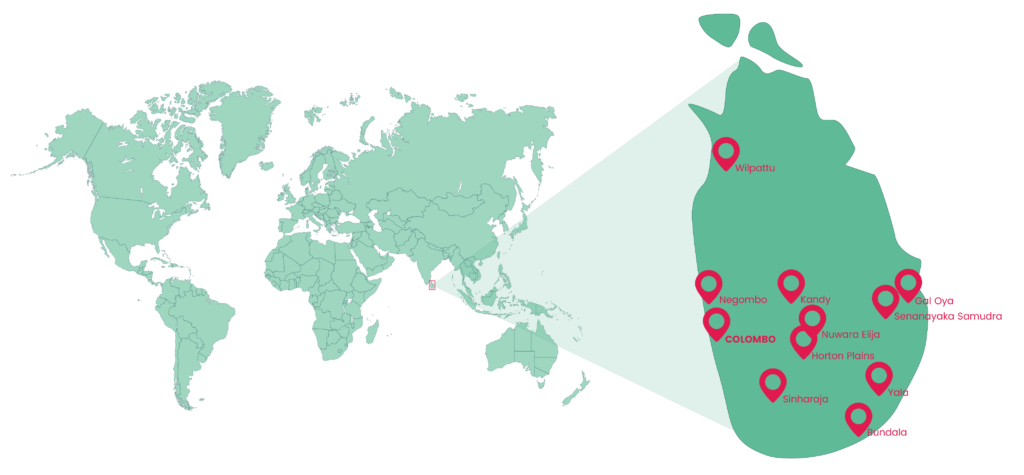Sri Lanka,
Resplendent Isle
Birdwatching along the lakes and mountains of the Pearl
Embark on a once-in-a-lifetime adventure to Sri Lanka: the Pearl of the Indian Ocean, India’s Teardrop, Serendip, the Resplendent Isle, the Island of Dharma… and a veritable birdwatching paradise! From the lively streets of Colombo to the serene lakes of Wilpattu, you’ll experience the diverse landscapes of this stunning island, each one home to a rich variety of birds and other wildlife. Explore the misty hills and sweeping grasslands of Horton Plains, wander through the dry-zone jungles of Yala, and immerse yourself in the lush rainforests of Sinharaja. Along the way, you’ll capture breathtaking moments and memories, all while discovering hundreds of amazing bird species, including about three dozen endemics! This trip isn’t just about seeing new places—it’s about seeing nature at its most spectacular.

US$ 5,999
/ person sharing
single supp. US$ 1,199
- 8-22 Oct 2025
- 15 days
- 6 to 10
- CMB
- CMB
Included
- 14 hotel nights.
- All meals from dinner on day 1 to breakfast on day 15.
- All in-country ground transport.
- Airport pick-up on day 1 and drop-off on day 15.
- All guiding fees for tour leaders and local guides.
- All entrance fees to sites mentioned in the itinerary.
- All activities as described in the itinerary.
- Global Rescue Membership*
Excluded
- International flights (to and from CMB).
- Alcoholic drinks.
- Camera and video permits.
- Personal purchases such as (but not limited to) laundry, room service, phone calls, souvenirs, etc.
- Insurance. We strongly recommend participants get travel, cancelation, and medical insurance in their home country.
- Any tips you would like to offer tour leaders, guides, drivers, porters, wait staff, housekeeping, etc. for outstanding service.
- Any other items not explicitly included.
Itinerary
Please note that while the general itinerary is set, hotels and daily activities may slightly differ depending on circumstances.
-
Day 1 ⎸ 8 October 2025: Arrival in Colombo
Your adventure begins the moment we collect you from the airport and take you to your hotel. After settling in, we'll gather for dinner and introductions and to go over the particulars of the trip.
-
Day 2 ⎸ 9 October 2025: Colombo to Wilpattu National Park
After a delicious breakfast, we head inland to the stunning Wilpattu National Park. After checking into our hotel and a quick lunch, we embark on an exciting evening safari. As one of Sri Lanka’s oldest and largest protected areas, Wilpattu—meaning "land of the lakes"—is a captivating mosaic of coastal shrub, grassy plains, dense forest, and the many “Willus” that gave the park its name: shallow limestone depressions that fill up with rainwater and attract a diverse range of wildlife. On this safari, you may see Sri Lankan Leopards, Sloth Bears, Spotted Deer, and Sri Lankan Elephants. But the real highlight for bird enthusiasts is of course the park’s vibrant birdlife: Sri Lanka Grey Hornbill, Malabar Trogon, Sri Lanka Hanging-Parrot, and Loten’s Sunbird, and a wide variety of waterbirds and shorebirds.
-
Day 3 ⎸ 10 October 2025: Wilpattu National Park
We’ll begin the day early to make the most of the cool morning climate when wildlife is most active. After a tasty breakfast served within the park at a scenic stop, we’ll head out for an unforgettable full-day safari. Our vehicles will be fully equipped with everything we need for a day of exploration, from sunrise to sunset. You’ll have ample opportunities to observe the park’s many bird species, including Sri Lanka Woodshrike, Sri Lankan Shama, Jerdon’s Leafbird, Cotton Pygmy-Goose, Indian Thick-knee, Sri Lanka Spurfowl, White-bellied Sea-Eagle, Asian Openbill, Greater Painted Snipe, and many more. With the whole day to immerse yourself in this wildlife haven, you’re sure to have countless moments of discovery and wonder.
-
Day 4 ⎸ 11 October 2025: Wilpattu National Park
As Sri Lanka's largest and most diverse wildlife sanctuary, Wilpattu deserves our maximum attention, so get ready for another full day of birding and wildlife watching. Breakfast and lunch will again be served within the park, allowing us to fully immerse ourselves in this breathtaking natural environment.
-
Day 5 ⎸ 12 October 2025: Wilpattu to Kandy
After a scenic three-hour drive from Wilpattu, we’ll arrive in Kandy, nestled in the lush hills of the Kandy plateau. This charming city, surrounded by tropical plantations and tea fields, is home to the revered Temple of the Tooth Relic (Sri Dalada Maligawa), one of the most sacred sites in the Buddhist world and a UNESCO World Heritage Site since 1988. Once we settle in, we’ll spend the afternoon birding in and around Kandy, where the tropical climate creates a perfect haven for birds like Malabar Pied Hornbill, Indian Pitta, Alexandrine Parakeet, Indian Paradise-Flycatcher, and Sri Lanka Green-Pigeon, among others. It’s the perfect blend of cultural exploration and birdwatching in a breathtaking setting.
-
Day 6 ⎸ 13 October 2025: Kandy to Nuwara Eliya
Today, we’ll journey from Kandy to Nuwara Eliya, a beautiful hill station known for its cool climate and colonial charm. After we arrive, we'll spend the late afternoon and evening immersed in urban birding. The city’s parks and green spaces are surprisingly rich with birdlife: You’ll get to observe fascinating species, including the Pied Thrush, which breeds in the Himalayas and spends its winters in Sri Lanka. Keep your eyes peeled for this rarity and other avian gems such as Sri Lanka White-eye, Grey-headed Canary-Flycatcher, Sri Lanka Blue-Magpie, and more as we explore the bird-filled urban landscape!
-
Day 7 ⎸ 14 October 2025: Horton Plains National Park and Hakgala Botanical Gardens
We’ll start the day early as we head to the montane grasslands and cloud forests of Horton Plains National Park. With a packed breakfast in hand, we’ll explore the park until lunchtime, immersing ourselves in its breathtaking landscapes. As we roam, we’ll have the chance to spot an impressive range of birds, including the endemic Yellow-eared Bulbul, Sri Lanka White-eye, Sri Lanka Junglefowl, Sri Lanka Whistling-Thrush, and migratory species like the Indian Pitta and Indian Blue Robin. Afterward, we’ll return to the hotel for a hearty lunch and a chance to relax with a short siesta. In the evening, we’ll visit the Hakgala Botanical Gardens, which again provide excellent opportunities to observe various birds, butterflies, dragonflies, and other fascinating critters. We’ll wrap up the day with a well-deserved dinner and a peaceful night’s sleep, ready for tomorrow's adventures.
-
Day 8 ⎸ 15 October 2025: Horton Plains to Gal Oya National Park
After breakfast, we’ll descend from the misty hills of Horton Plains and head towards Gal Oya National Park. Once we arrive and check in at our lodge, we’ll enjoy a relaxing lunch before heading out for some light birding in the area around the lodge. The park’s unique landscapes offer a perfect backdrop for spotting a variety of bird species, including Sri Lanka Junglefowl, Red-backed and Crimson-backed flamebacks, Sri Lanka Scimitar-Babbler, etcetera.
-
Day 9 ⎸ 16 October 2025: Gal Oya National Park and Senanayaka Samudraya
We’ll start the day early with an exciting boat exploration of the Senanayaka Samudraya reservoir, keeping our eyes peeled for Small Pratincole, Great Thick-knee, Little Ringed Plover, Red-wattled Lapwing, Richard's and Paddyfield pipits, and Whiskered Tern, among others. After our morning of birdwatching, we’ll return to the lodge for a hearty lunch and some downtime. In the late afternoon, we’ll head back to Gal Oya National Park for more birding.
-
Day 10 ⎸ 17 October 2025: Gal Oya to Yala National Park
After leaving the wilds of Gal Oya, we’ll drive to the dry-zone jungles of Yala National Park. After checking into our hotel and enjoying a delicious lunch, we’ll head out for an afternoon of birding in the park. While Yala is primarily famous for its high density of Sri Lanka Leopards, it also offers fantastic opportunities to spot a wide variety of dry-zone bird species such as the vibrant Asian Green and Chestnut-headed bee-eaters. You’ll also have the chance to observe endemics like the Sri Lanka Junglefowl, Sri Lanka Grey Hornbill, and Sri Lanka Woodshrike. We’ll also explore some of the park’s lakes and mudflats, which are teeming with waterfowl and shorebirds.
-
Day 11 ⎸ 18 October 2025: Yala and Bundala National Park
We’ll enjoy a final morning in Gal Oya before heading to Bundala National Park, an amazing RAMSAR site and UNESCO Biosphere Reserve. Bundala is a crucial stopover for migratory birds and a haven for wintering species. You’ll have the opportunity to spot dozens of wetland and dry-zone species, both resident and migratory, as we explore this biodiverse landscape. After another rewarding day of birding, we’ll head back to the hotel to unwind with a delicious dinner and cocktails, followed by a well-deserved rest, reflecting on the incredible birdlife we’ve experienced throughout the day.
-
Day 12 ⎸ 19 October 2025: Sinharaja Rainforest
Get ready for the grand finale of our birding adventure as we leave the dry-zone jungles of Yala and head to the enchanting Sinharaja Rainforest. While we’ve explored many of Sri Lanka's diverse habitats, this final stop may just be the most extraordinary of them all. Located in the southwest of the island, Sinharaja is one of the last remaining stretches of viable primary rainforest in Sri Lanka, teeming with endemic flora and fauna: Over 60% of the plants and 50% of the mammals and butterflies here are unique to the area. Among the 34 species of endemic birds found in Sri Lanka, 25 can be spotted in this lush haven! After checking into our hotel and enjoying a delicious lunch, we’ll head out for an afternoon birding session. We’ll be on the lookout for Red-faced Malkoha, Sri Lanka Blue-Magpie, Ashy-headed Laughingthrush, Sri Lanka Thrush, Sri Lanka Myna, Sri Lanka Green-Pigeon, and Sri Lanka Spurfowl. As the evening sets in, we may take a short night walk around the lodge, searching for owls, nightjars, and other nocturnal creatures that call this rainforest home.
-
Day 13 ⎸ 20 October 2025: Sinharaja Rainforest
Prepare for one more full day of birding in the captivating Sinharaja Rainforest! Today, we’ll venture deeper into the forest reserve, immersing ourselves in the true primary rainforest experience. As we explore, you’ll have the chance to spot some of Sri Lanka’s most iconic Sri Lanka Spurfowl, Layard’s Parakeet, Serendib Scops-Owl, Red-faced Malkoha, Green-billed Coucal, Malabar Trogon, Brown-backed Needletail, Yellow-fronted Barbet, Yellow-browed Bulbul, Spot-winged Thrush, Orange-billed Babbler, White-faced Starling, Black-throated Munia, or Crested Drongo. And of course, we’ll look out for Sri Lanka Leopard, Sloth Bear, Elephants, and other big game, too. With the rich biodiversity of the rainforest surrounding us, you’ll never know what incredible bird or wildlife encounter awaits next. It’s a day full of discovery and adventure in one of the island’s most biodiverse ecosystems!
-
Day 14 ⎸ 21 October 2025: Sinharaja Rainforest to Negombo
As our Sri Lanka birding adventure comes to a close, we’ll head back into the rainforest one last time to search for any species we may have missed. We’ll then make our way to the coastal town of Negombo. Here, you’ll have the chance to bird along the beautiful beach and explore the rich birdlife of the Negombo Lagoon. It’s the perfect way to wrap up an unforgettable birdwatching journey.
-
Day 15 ⎸ 22 October 2025: Departure from Colombo
After an unforgettable fortnight of exploring the wild beauty of Sri Lanka, it’s time to say our goodbyes to the island and our fellow travelers, and board our flight home. Over the course of our journey, you’ll have immersed yourself in the island’s rich wildlife and diverse ecosystems. From Sri Lanka’s misty hills to its coastal lagoons and dry-zone jungles, you’ll leave with lasting memories of an incredible birdwatching adventure on the Pearl of the Indian Ocean.


